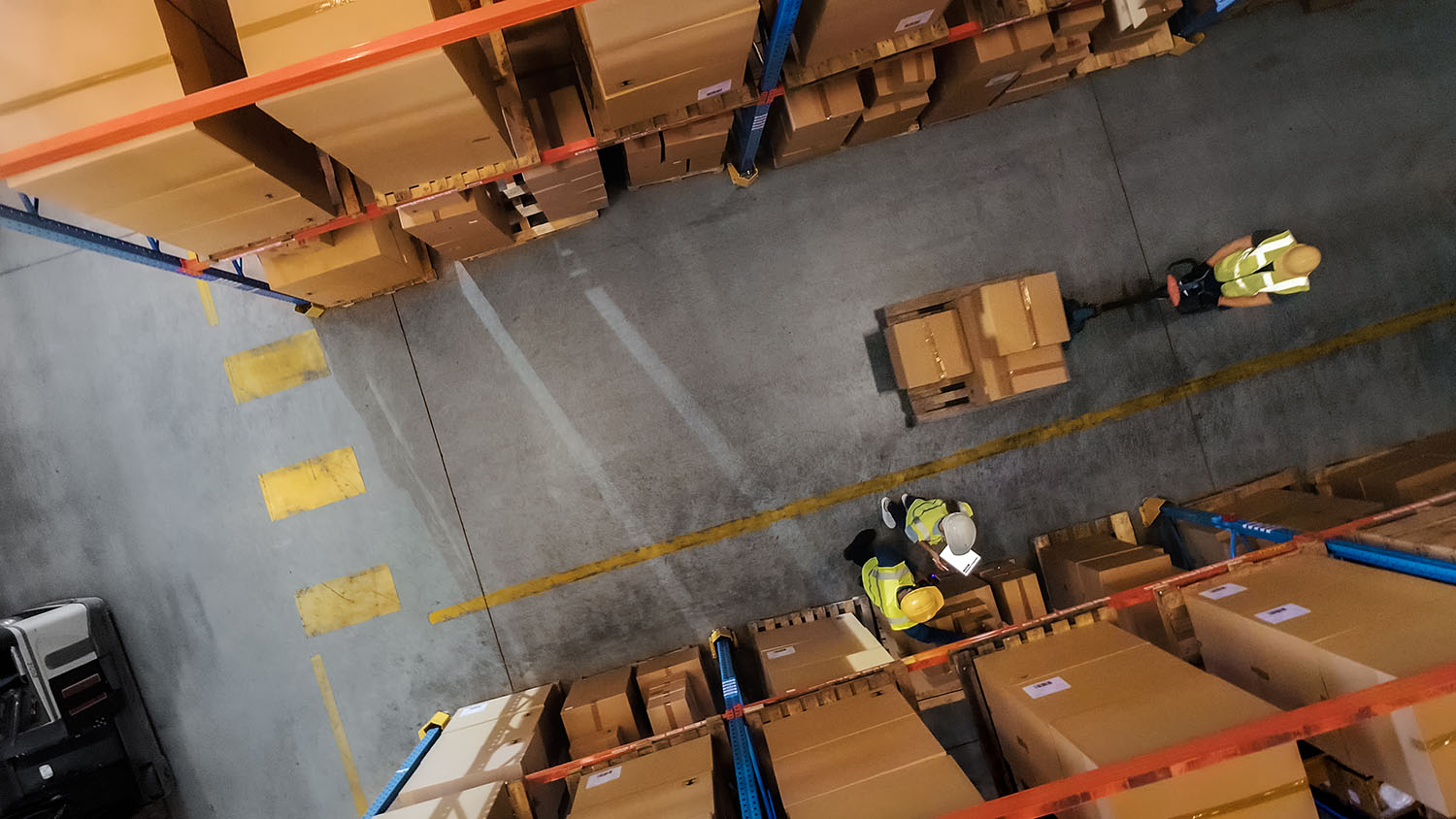Every time a customer gets their package on time, a lot has happened behind the scenes. Someone stocked that item, someone packed it, and someone made sure it got on the right vehicle for shipment.
The act of plotting the strategy behind all that behind-the-scenes magic is called distribution management.
Distribution management—a term sometimes used interchangeably with product distribution—describes the subset of supply chain management where transportation planning, warehouse operations, and customer fulfillment all meet.
If logistics is the execution, think of distribution management is the planning of the full downstream movement of goods from the point of origin to the final customer destination. This includes storing the items, keeping track of them, preparing them for delivery, and making sure they get shipped. Distribution management is how 3PLs set the strategy to get faster and more organized and reliable.
In this article, we will discuss everything you need to know about distribution management. So, let’s get going.
What is Distribution Management for 3PLs?
Distribution management is how you move goods from the factory to the end consumer. As a 3PL, you’re in charge of every step. You receive inventory, store it, pick and pack orders, and hand them off to carriers. Your job is to do all of this fast, without errors, and in a cost-efficient manner.
Key Components of Distribution Management
Distribution management involves several steps that need to work together.
Here’s what goes into getting it right.
Inventory Management
“The lack of Inventory management skills or poor inventory management pulls the service provider from the competition in the industry. The profitability of a 3PL organisation is tied to the accuracy of the client’s stock, which has a direct impact.” — Relevance of Inventory Accuracy from a 3PL Service Provider Perspective
Inventory is the backbone of distribution. You need to know what you have, where it is, and when to restock. You also need to avoid holding too much stock or running out when customers place orders.
A strong inventory management process helps you:
- Keep the right stock levels based on demand
- Avoid dead stock sitting for weeks and stockouts that might lead to not meeting SLAs
- Maintain accuracy between what’s on the floor and what’s in the system.
A WMS like Da Vinci Unified offers live visibility into inventory across multiple warehouses. You can set rules for replenishment, reduce shrinkage, and avoid guesswork.
Order Processing
Order processing is where many bottlenecks, like delayed wave releases, short picks, or label printing issues, happen.
That’s why you need an order management system that helps you manage every step, from receiving the order to delivering it correctly.
Effective order processing includes:
- Barcode scanning to reduce mispicks
- Optimized pick and pack workflows
- Automated shipping labeling generation and documentation (UCC-128 if you’re serving retail)
- Handling returns without headaches.
Warehousing
A poor warehouse layout slows down picking, increases errors, and creates bottlenecks during busy periods. A smart layout groups inventory by client, shortens pick routes, and leaves space for tasks like kitting and staging, where items are prepared and organized before shipping to speed up order fulfillment.
With Da Vinci’s WMS, you can:
- Use directed putaway to store faster and smarter
- Use cart picking or wave picking to cut walk time
- Use cross-docking to bypass storage for fast-moving items.
Whether you’re managing temperature-sensitive goods or apparel with many SKUs, Da Vinci helps you move orders quickly. With customizable workflows, automated order routing, and real-time tracking, you can improve operations without changing your existing setup.
Transportation
A 3PL’s job doesn’t end when the product leaves the warehouse. The next step is getting it to the customer quickly and safely. That’s where effective transportation management comes in. It includes:
- Route optimization to reduce fuel consumption and delivery time
- Choosing the most suitable carrier for each type of shipment, whether it’s an urgent delivery or a standard order
- Tracking deliveries in real time to stay on top of progress and address any issues.
Customer Service
As a 3PL, your team is the first to handle customer questions about orders, delays, or returns. Without a connected system, the customer service team will end up chasing warehouse updates.
A good WMS solves this by giving your team instant access to key information, allowing them to:
- Check order status without calling the warehouse
- Confirm when items were picked, packed, or scanned
- Explain shipping delays with exact timestamps
- Process returns or exceptions without interrupting warehouse operations.
Different Types of Distribution Channels
A distribution channel is the pathway through which a product reaches the consumer. The choice of channel impacts your speed, margins, and customer satisfaction.
As a 3PL, you’re likely serving all four of these:
- Wholesalers: You’re shipping by the pallet. Orders are large and infrequent, but accuracy and UCC-128 compliance still matter. This is common for food, beverages, and consumer goods.
- Retailers: They expect perfect labeling, on-time delivery, and shelf-ready shipments. Whether it’s department stores or regional chains, you’ll often send mixed-SKU cases. You also have to follow the routing guide requirements and comply with advanced shipping notices (ASNs).
- Distributors: These middlemen need bulk product storage, flexible order volumes, and often relabeling. As their 3PL, you handle warehousing and order fulfillment.
- E-commerce: Direct-to-consumer (D2C) fulfillment demands speed. You have to ship individual parcels, often same-day, with near-zero error tolerance. Inventory needs to sync across Shopify, Amazon, and marketplaces without lag.
Distribution Management vs. Logistics: What’s the Difference
Distribution management and logistics are often used interchangeably in the 3PL industry, but they’re not the same. Here’s a simple breakdown:
Logistics = Physical Handling of Goods
Logistics focuses on the physical aspects of getting products from point A to point B. This includes:
- Transportation: Booking carriers, planning routes, and making sure shipments arrive on time.
- Warehousing: Receiving, storing, and organizing inventory by client, SKU, or temperature zone.
- Inventory Handling: Counting, scanning, rotating, and managing stock to prevent errors and loss.
This is the work your dock staff, scanners, forklifts, and dispatch team handle every day.
Distribution Management = The Strategy Behind It
Distribution management covers the bigger picture. It gives structure to logistics by adding systems and planning that help things run smoothly.
It focuses on:
- Demand Planning: Making sure you have the right stock in the right place before orders arrive.
- Order Management: Focusing on meeting SLAs, grouping orders for picking, and printing shipping documents.
- Customer Service: Sharing order status, return status, and purchase order (PO) updates without having to check the warehouse floor.
- Channel Strategy: Handling retail, e-commerce, and wholesale without needing separate workflows.
When powered by the right WMS, distribution management keeps 3PL logistics aligned across multiple warehouses.
Challenges in Distribution Management & How to Solve Them
Many businesses are turning to automation because distribution is getting harder to manage. Without the right WMS, the risks pile up.
Here’s what you’re up against:
Supply Chain Disruptions
Natural disasters, pandemics, and labor strikes can delay inbound shipments and create uncertainty across the supply chain. These disruptions often lead to inventory shortages or stockouts, especially when stock arrives late or not at all.
A WMS helps 3PLs respond quickly by providing real-time visibility into inventory across all warehouse locations. When one site is affected, you can shift fulfillment to another, reroute shipments, or prioritize urgent orders, helping clients stay on schedule despite the disruption.
Demand Fluctuations
Changes in consumer behavior, like during holidays or sales, can lead to too much or too little inventory. If you’re not prepared, you risk overstocking or running out of stock.
A good solution is to rely on real-time inventory data and forecasting tools. A WMS helps you spot trends by product, zone, and customer. This way, you can make smarter decisions before small changes become bigger issues.
Transportation Issues
Even the best-planned deliveries can go off track due to real-world setbacks. Trucks break down, drivers call in sick, or weather conditions force road closures. These disruptions can snowball, leading to missed delivery windows and unhappy customers.
You can manage this with dynamic routing, smart load planning, and real-time tracking. A transport management system (TMS) linked to your WMS helps 3PLs pick better routes and assign the right carriers. It also tracks shipments in real time. This helps prevent unexpected delays that could affect customer satisfaction.
Coordination Problems
Miscommunication between suppliers, warehouse teams, and carriers often leads to shipment errors, delayed orders, and inventory mismatches. These issues usually happen when each party works in silos and there’s no shared visibility.
A WMS like Da Vinci solves this by giving everyone access to the same real-time data—inventory levels, order status, and delivery timelines. With a unified system, 3PLs can coordinate across the supply chain more effectively, reduce errors, and keep operations running smoothly.
Cost Management
Distribution gets expensive when operations aren’t optimized. Rushed deliveries increase fuel costs, and inefficient warehouse layouts lead to longer picking times and higher labor spend. Over time, these small inefficiencies can erode profit margins.
3PLs can control costs by using strategies like load consolidation, zone-based picking, and lean inventory management. A WMS supports this by tracking labor hours, automating customer billing, and adjusting picking routes to save time. With the right system in place, you can reduce overhead without compromising on speed or accuracy.
Returns Handling
Returns are a growing challenge, especially for 3PLs handling e-commerce. Items often come back damaged, mislabeled, or without proper packaging. Without a clear reverse logistics process, returned goods can get lost, delayed, or miscategorized, leading to lost revenue and unhappy clients.
You need a return flow that’s as organized as outbound shipping. That means:
- Tagging damaged goods right away
- Restocking clean items fast
- Recording the reason for each return.
A 3PL WMS makes this possible by automating return workflows, applying custom restocking rules, and generating detailed return reports. This ensures faster turnaround, cleaner inventory data, and greater trust from your clients.
Benefits of Strong Distribution Management
When you nail your distribution management, everything else runs smoothly. Here’s what you gain:
Higher Profit Margins
When your inventory moves quickly, less of your cash gets stuck sitting on shelves. You avoid markdowns, expired products, and wasted storage space. An inventory management strategy reduces shrinkage, like damaged goods, miscounts, or missing stock. This means you can fulfill more orders with less wasted space, which boosts your margins.
Improved Customer Satisfaction
Late shipments and missing items can create support tickets, refunds, and bad reviews. But when every order goes out on time, your customers stay happy. This builds trust and increases your client retention rate.
Better Market Competitiveness
With the right distribution data, you can spot demand shifts early. If one region starts buying more, you can quickly shift stock to meet the demand. You can also help your clients launch products sooner, avoid backorders, and restock items based on trends and data.
Nailing Distribution Management with Da Vinci’s WMS
Distribution management connects inventory, warehousing, order flow, transportation, and customer service. When done right, it helps you grow without adding complexity. You can support multiple channels, reduce errors, meet demand, and avoid overspending.
Da Vinci’s WMS helps you do just that. It offers real-time tracking, easy integrations, and flexible tools that grow with your business.
Request a demo today to see how our software can help you with your distribution management.



